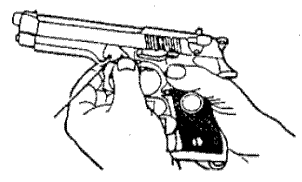|
This video was produced by the US
Army as an instructional aid, demonstrating the safe use of the M9 9mm
Automatic Pistol. The video may be helpful to those using firearms in
their work, or those who may encounter firearms and need the knowledge
of safe handling of these weapons.
The video may be freely
downloaded.
|

Helpful Tips in Firing this Weapon:
-
While the9 mm projectile can travel
up to a mile, the nature of the weapon makes it effective only at
very close range. Unless you are highly practiced with this pistol,
you are not likely to hit your target if it is more than 25 feet
from you.
-
Aim for the center of the torso. You
are least likely to miss this area.
-
Use two hands to hold the pistol.
You will shoot more accurately.
-
Two shots in quick succession (1/2
to 1 second apart) are more likely to stop your target than a single
shot. While the 9 mm round can certainly be lethal if it hits the
right spot, it is a relatively small, lightweight, low speed
projectile with only limited stopping power. Particularly when
trying to stop an adrenalin-charged, highly-motivated individual,
multiple hits from your 9 mm pistol may be required. However,
emptying a full magazine into your target is also unwise, as it may
leave you with no ammunition to take on his three angry friends.
-
When defending against multiple
targets, try to stop the most threatening target first. Usually that
is the target closest to you. However, someone with an automatic
weapon or shotgun is more dangerous to you and your patients than
someone with a pistol. Likewise, someone with a rifle is more
dangerous than someone with a pistol.
-
Take advantage of any cover you may
have. Crouching behind a rock or packing crate is much better than
standing out in the open. If you are caught out in the open, quickly
make a decision to either go to the ground, or to run to cover. If
you go to ground, keep moving (rolling, crawling), to decrease the
chance of your being wounded.
-
Should you become wounded, keep
shooting. The best defense against incoming fire is to return fire,
wounded or not.
-
Should the weapon fail to fire, use
the "Slap, Rack, and Bang"
technique:
-
Slap the base of the
Grip to more firmly seat the magazine.
-
Rack the slide
backward and release, ejecting the old cartridge and bringing a
fresh cartridge into the chamber.
-
Bang goes the pistol
when you pull the trigger again.
For further information on the M9 9
Millimeter Semi-Automatic Pistol, read:
M9 Service Pistol Familiarization
FM 21-75: Combat Skills of the Soldier
Emergency War Surgery NATO Handbook: Part I: Types of Wounds and
Injuries: Chapter II: Missile-Caused Wounds: Projectiles
From Operational Medicine 2001
|

